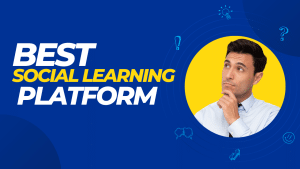Every business grows by staying ahead in this internet age. This means entering the knowledge economy, where continuous learning and upskilling are crucial. Organizations must adopt a company culture promoting growth through new skills and opportunities. A learning path guides employees toward both personal and professional development.
A learning path is like a journey map in different work environments. It offers structured online training and practical skills necessary for job success. Think of it as a call to action for anyone looking to improve or gain new skills. It provides a clear route to effectively acquiring and applying knowledge within any business ecosystem. In this blog, we will explain what a learning path is and how it can be helpful for you.
What is a Learning Path?
A learning path is like a map for learning. It shows the route from not knowing to knowing much about a subject. This path helps learners start at a clear-defined beginning, make their way through a middle, and reach an end where they have mastery over a new skill. In this journey, milestones help gauge progress. It’s a modern-day response to the need for building knowledge.
Companies use a Learning Management System (LMS) to simultaneously let employees and trainees enroll in different courses. This way, companies save time and costs. Each learning path is well-planned, with specific milestones and courses. It’s about achieving goals and getting better at your job or sharpening the saw, as they say. It’s all about progressively moving past each phase with overall satisfaction and good user experience.
Also Read: What is Vicarious Learning
Types of Learning Paths

There are three learning paths:
- Successive
- Alternative
- Level
Each one helps achieve different goals. Let’s discuss them in detail.
Successive
Successive paths are like a step ladder. Administrators make a list of courses that start easy and get more challenging. Learners have to finish one course, pass a test, and then they can move on to the next one. This way, everyone follows the same route and learns things in order.
Alternative
Alternative paths let learners choose a bit. They can skip parts that are not important and focus on the must-do courses. This path is flexible. Teachers mix mandatory and optional parts but ensure everyone meets the goals.
Level
Level paths involve climbing up stages. Administrators set up different levels, and you move up after mastering each level. The path mixes mandatory and optional courses, letting learners choose how fast they go but ensuring they learn what is needed before advancing.
Also Read: Importance of Compliance Training
Step To Create a Learning Path For Employees in an Easy Way

LearnWorlds is a standout choice for those wanting to build a high-converting course website. It’s perfect for crafting learning experiences that an audience will love. Whether you’re a chef, yoga instructor, or teacher, you can monetize your knowledge and passion. This platform makes it easy to sell courses, memberships, course bundles, and subscriptions. You can make your offers more tempting with Upsell and cross-sell options, plus attractive offers and promotions. LearnWorlds comes packed with a user-friendly website builder, effective marketing tools, and affiliate programs. And handling checkout and payments? It’s all very simple. Plus, you get detailed analytics and reports to track success. These helpful features make LearnWorlds an incredible solution for anyone looking to create an online community and turn their knowledge into a source of recurring income.
- Reason to Choose LearnWorlds: We chose LearnWorlds for its fast course creation, ever-improving platform, reliable website, and top-notch support. It’s the perfect choice for hassle-free online course development
Let’s discuss some main steps in detail.
Determine Roadmaps
To build a career, define the roadmaps for different job positions and roles within a department or team. Think of each employee’s journey from entry-level employees to making horizontal moves or climbing up the ladder. It’s about seeing the larger picture where different personality types are accommodated and paths are blended. For example, an HR assistant might grow to become a recruiter, etc.
Identifying Skill Gaps
Every company needs to match its employees’ skills with its goals. This starts by identifying skills gaps through assessments. Competency-based management helps effectively operate an enterprise by lining up team needs with company objectives. It’s about preparing for the future, like setting succession plans for leadership roles and creating paths that align with employees’ goals and interests.
Also Read: What is Competency Management?
Training Needs
Figuring out training needs is critical. Some training is in-house, and some might be outsourced. It’s about getting personnel the help they need from mentors or leaders. Regular surveys help understand what staff need and if there’s a need to recruit more help internally.
Benefits of Learning Path for Employees

Companies use learning paths in their upskilling programs to boost skills and engagement at work. These paths benefit the company and employees, creating a win-win situation with many rewards for workers. Let’s discuss some benefits in detail.
Structured and Sequenced Learning
Learning paths help employees by making learning structured. Administrators set up the courses in a specific order and sequence, which allows employees to know exactly what they need to learn next. They have the freedom to learn at their own pace, which makes them more comfortable and engaged.
Accelerated Learning & Development Goals
Learning paths speed up employees’ growth. They learn skills that the company needs right now, which is good for both the employees and the company because it helps everyone grow together. Employees use what they learn immediately, making the learning feel more valuable and relevant.
Self-Paced Learning
With learning paths, employees can learn new things at their own speed. This method respects their abilities and how fast they can learn and implement information. It’s all about making learning fit the learner, not the other way around. This personal touch means employees are more likely to meet their goals and feel good about their learning journeys.
Saves Time
Learning paths also save a lot of time for those who manage training. Administrators can set up courses once, and then employees can start them without needing extra help each time. This makes the whole process smoother and lets admins focus on other essential tasks.
Continuous Feedback
Feedback is a big part of learning paths. Employees receive comments and help throughout their courses, which means they can improve continuously. Administrators can see how well the training is going and make changes if needed, keeping everything working well and helping employees keep getting better.
Also Read: Bespoke eLearning
Final Thoughts
In any company, a learning path is a roadmap that helps employees enhance their skills and abilities. It’s all about setting milestones along the route to success. This development journey leads to exponential long-term rewards, benefiting both the enterprise and its employees. Learning paths focus on engagement, performance, and reduced costs, creating strong bonds with trainees. Creating this roadmap takes time, but it makes a big difference once completed. Employees who follow it improve much faster.






